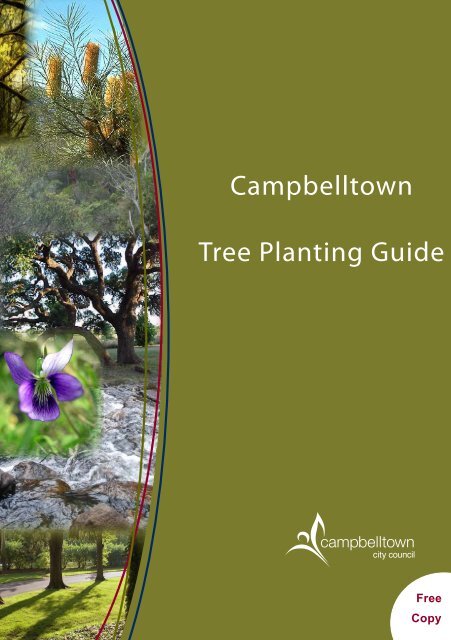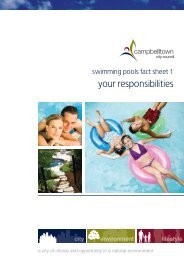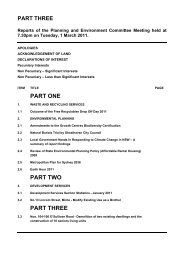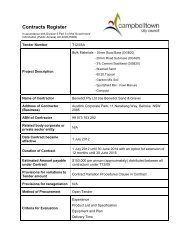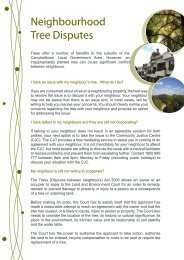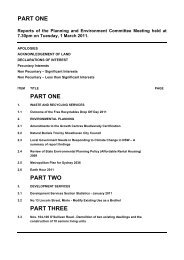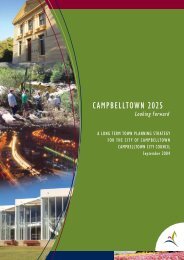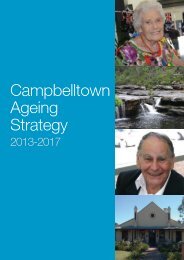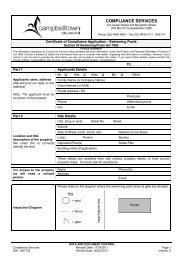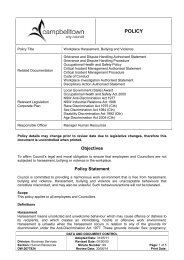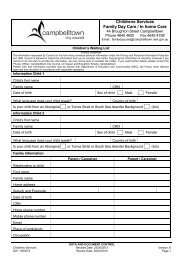Campbelltown Tree Planting Guide - Campbelltown City Council
Campbelltown Tree Planting Guide - Campbelltown City Council
Campbelltown Tree Planting Guide - Campbelltown City Council
You also want an ePaper? Increase the reach of your titles
YUMPU automatically turns print PDFs into web optimized ePapers that Google loves.
<strong>Campbelltown</strong><br />
<strong>Tree</strong> <strong>Planting</strong> <strong>Guide</strong><br />
Free<br />
Copy
<strong>Tree</strong> <strong>Planting</strong> <strong>Guide</strong><br />
<strong>Tree</strong> <strong>Planting</strong> <strong>Guide</strong>
Contents<br />
<strong>Tree</strong> <strong>Planting</strong> <strong>Guide</strong><br />
Introduction and Purpose of the <strong>Guide</strong> 2<br />
Other <strong>Tree</strong> Related Information Provided by <strong>Council</strong> 3<br />
Why Plant <strong>Tree</strong>s? 3<br />
<strong>Tree</strong>s Need the Right Soil 5<br />
What <strong>Tree</strong> to Plant Where 6<br />
<strong>Planting</strong> Near Overhead Lines 6<br />
<strong>Planting</strong> Near Footpaths and Underground Services 6<br />
Dropping Leaves and Seeds 7<br />
<strong>Planting</strong> Near Buildings 8<br />
<strong>Planting</strong> Near Driveways 9<br />
Consider Your Neighbours 9<br />
<strong>Planting</strong> Local Native Species 10<br />
Mixing Exotic and Native Species 10<br />
Inappropriate Species to Plant 10<br />
Hedges 12<br />
Termites 13<br />
1
<strong>Tree</strong> <strong>Planting</strong> <strong>Guide</strong><br />
<strong>Tree</strong> <strong>Planting</strong> <strong>Guide</strong><br />
Introduction and Purpose of the <strong>Guide</strong><br />
<strong>Tree</strong>s are a very important part of our <strong>City</strong>. They provide a number of<br />
benefits for both people and the environment, and they also play an<br />
important role in creating the character or feel of a suburb or locality.<br />
However, trees can cause a number of problems if planted in an<br />
unsuitable position. They can cause<br />
damage to footpaths, underground<br />
pipes, buildings and can also<br />
create problems for neighbours<br />
by blocking sunlight or dropping<br />
leaves and branches. With some<br />
simple planning, you can prevent<br />
many of these problems from<br />
occurring.<br />
The purpose of this <strong>Guide</strong> is to<br />
help people choose the right type<br />
of tree for their property, and find<br />
the right place to plant it. Please<br />
note that this <strong>Guide</strong> only relates to<br />
private land, and that people must<br />
not plant trees or shrubs on the<br />
nature strip, or other <strong>Council</strong><br />
property such as Reserves and Parks.<br />
Please read through the <strong>Guide</strong> and think about how the topics relate to<br />
your property. Identifying possible problems and addressing them before<br />
a tree is planted is a much better option than dealing with problems in<br />
the future.<br />
If you have any further questions about selecting trees for your garden,<br />
please talk to your local nursery. Their staff may be able to assist you.<br />
2
Other <strong>Tree</strong> Related Information Provided by <strong>Council</strong><br />
As well as this <strong>Tree</strong> <strong>Planting</strong> <strong>Guide</strong>, <strong>Council</strong> also has a series of Fact<br />
Sheets on tree related topics including:<br />
<strong>Tree</strong> <strong>Planting</strong> <strong>Guide</strong><br />
· Removal of Fallen <strong>Tree</strong>s and Branches<br />
Following Storm Events<br />
· Neighbourhood <strong>Tree</strong> Disputes<br />
· Native Gardening <strong>Guide</strong> for the <strong>Campbelltown</strong><br />
Local Government Area<br />
These fact sheets are available on <strong>Council</strong>’s website, and from <strong>Council</strong>’s<br />
Civic Centre and branch libraries.<br />
<strong>Council</strong> is currently reviewing its requirements for the removal or trimming<br />
of trees within the <strong>City</strong>. Once this has been completed, a “Trimming and<br />
Removing <strong>Tree</strong>s” fact sheet will also be available.<br />
Why Plant <strong>Tree</strong>s?<br />
<strong>Tree</strong>s benefit the environment and our<br />
community in a number of ways, and can<br />
also provide financial benefits to residents<br />
by reducing cooling costs. Listed over the<br />
page are some of the ways in which trees<br />
benefit the <strong>Campbelltown</strong> area.<br />
3
<strong>Tree</strong> <strong>Planting</strong> <strong>Guide</strong><br />
•<br />
•<br />
•<br />
•<br />
•<br />
•<br />
•<br />
•<br />
•<br />
•<br />
•<br />
<strong>Tree</strong> <strong>Planting</strong> <strong>Guide</strong><br />
<strong>Tree</strong>s create shade for streets and backyards. In Summer this helps<br />
to lower the temperature and make these areas more comfortable.<br />
<strong>Tree</strong>s can create privacy for residents.<br />
<strong>Tree</strong>s native to the local area can provide habitat for native animals<br />
such as koalas, birds, insects and other native animals.<br />
<strong>Planting</strong> local native trees may help to discourage feral pests such<br />
as the Indian Myna bird.<br />
<strong>Tree</strong>s add a pleasant atmosphere to streets and gardens. They<br />
promote a sense of neighbourhood amenity.<br />
<strong>Tree</strong>s can be used to frame views or to complement building design.<br />
A well designed and maintained garden with trees may add value to<br />
a property.<br />
<strong>Tree</strong>s and their flowers can create delicate scents in the garden.<br />
<strong>Tree</strong>s can create a place for children to play. This encourages children<br />
to be active and to use their imaginations in a natural setting.<br />
<strong>Tree</strong>s help to improve the quality of stormwater. They do this by<br />
preventing soil erosion and encouraging water to soak into the soil,<br />
which reduces the amount of surface run off.<br />
<strong>Tree</strong>s improve the atmosphere. They do this by absorbing carbon<br />
dioxide and airborne pollutants, and releasing oxygen to the air.<br />
<strong>Tree</strong>s help to create the character of our local suburbs.<br />
4
<strong>Tree</strong>s Need The Right Soil<br />
The <strong>Campbelltown</strong> area has a number of soil types, which have different<br />
characteristics. Plants are often suited to particular soil conditions. If you<br />
know your soil type, you can choose trees appropriate for your garden.<br />
Below is a map showing the main soil types in <strong>Campbelltown</strong>.<br />
<strong>Tree</strong> <strong>Planting</strong> <strong>Guide</strong><br />
Elderslie - sand and sandy clay<br />
Hawkesbury - sand<br />
Hammondville - sand and sandy clay<br />
Cumberland - clay and sandy clay<br />
Menangle - clay and sandy clay<br />
Alluvium - sand, clay<br />
and loam<br />
However, in many residential situations the characteristics of the soil<br />
may have changed, and may require the addition of a suitable top soil.<br />
Please contact your local nursery if you need help in determining the soil<br />
type at your property.<br />
5
<strong>Tree</strong> <strong>Planting</strong> <strong>Guide</strong><br />
<strong>Tree</strong> <strong>Planting</strong> <strong>Guide</strong><br />
What <strong>Tree</strong> to Plant Where<br />
It is important to plant a tree which is suitable for the chosen location.<br />
Simple planning can reduce the likelihood of problems occurring in the<br />
future. The following are some factors to consider before planting a<br />
tree.<br />
<strong>Planting</strong> Near Overhead Lines<br />
Care should be taken when<br />
planting trees near overhead<br />
powerlines. <strong>Tree</strong>s planted in this<br />
location are extremely difficult to<br />
maintain and pose a safety threat<br />
to both people and property. Do<br />
not plant a tree directly underneath<br />
overhead lines.<br />
When planting a tree near<br />
overhead lines, you need to<br />
choose the species carefully.<br />
Tall species or those with a large<br />
canopy can interfere with overhead lines, even when they are not planted<br />
immediately adjacent to them.<br />
<strong>Planting</strong> Near Footpaths and Underground Services<br />
Many people establish trees and other plants too close to footpaths<br />
and services such as underground pipes and wiring. This can cause<br />
problems which can be dangerous and costly to repair.<br />
Residents in older suburbs should be particularly careful when choosing<br />
which tree species to plant. Many older suburbs have earthenware<br />
drainage and sewerage pipes which are particularly prone to leakage.<br />
This, in turn, attracts tree roots which then can cause further damage<br />
to pipes.<br />
6
As a guide, small trees and shrubs should be planted at least 3 metres<br />
away from underground services. <strong>Tree</strong>s with a mature height of over<br />
8 metres should be planted at least 5 metres away from underground<br />
services. For further information, contact your local nursery.<br />
<strong>Tree</strong> <strong>Planting</strong> <strong>Guide</strong><br />
One way of locating underground services<br />
on private property is to call “Dial before<br />
you dig” on 1100 and request plans<br />
of any underground services on the<br />
property. Please note that not all service<br />
providers participate in this programme,<br />
and that additional services may have<br />
been installed without the knowledge of<br />
the relevant authorities. For this reason,<br />
exercise caution when planting trees<br />
and shrubs adjacent to or near to underground<br />
services.<br />
Make sure you allow enough room for access to items such as manhole<br />
covers and water meters. These may need to be accessed at any time,<br />
so clear access needs to be maintained.<br />
Take care when planting trees near footpaths. Large root systems can<br />
disturb and damage them, and branches can interfere with people<br />
walking along the footpath. It is the resident’s responsibility to ensure<br />
that there is a 2.2m clearance above the footpath, and that the roots<br />
from the tree do no interfere with the path.<br />
As mentioned previously, residents are not authorised to plant trees<br />
on the nature strip.<br />
Dropping Leaves and Seeds<br />
When planting a tree or shrub consider how much maintenance it will<br />
require, whether its seeds will create a safety hazard on footpaths and<br />
whether its leaves will fall into a neighbour’s property.<br />
7
<strong>Tree</strong> <strong>Planting</strong> <strong>Guide</strong><br />
<strong>Tree</strong> <strong>Planting</strong> <strong>Guide</strong><br />
Debris from plants can pose a safety problem when they land on<br />
footpaths or areas that are commonly used by people. Sticks can<br />
pose a trip hazard, and things like seed pods and gum nuts can be<br />
slippery under foot. These are particularly hazardous for elderly people<br />
and people with limited mobility. Therefore, avoid planting trees which<br />
will drop these objects near footpaths or other areas which are used<br />
regularly.<br />
Another common mistake is for people to plant trees which drop a lot<br />
of leaves or seeds near swimming pools. This requires more work in<br />
maintaining a pool, and creates more work for pool chemicals and<br />
equipment.<br />
People should also consider whether items from the tree that is to be<br />
planted are likely to drop or be blown into a neighbour’s yard.<br />
<strong>Planting</strong> Near Buildings<br />
Large trees can present a hazard in storms and have the potential to<br />
cause major damage to property. When planting a large tree near a<br />
house, place it at least half its mature height away from any building.<br />
8
For example, if a tree grows to a mature height of 10 metres, plant<br />
the tree at least 5 metres away from any building. This will reduce the<br />
potential impact from a future fall.<br />
<strong>Tree</strong> <strong>Planting</strong> <strong>Guide</strong><br />
Once a tree is 3m in height, or the trunk has a diameter of 150mm or<br />
more, you must apply to <strong>Council</strong> to have it trimmed or removed. The<br />
fact that you have planted a tree does not give you authority to trim or<br />
remove the tree.<br />
<strong>Planting</strong> Near Driveways<br />
One issue that is commonly overlooked when planting a tree is allowing<br />
sufficient ‘line of sight’ for both an individual’s and the neighbours’<br />
driveways. Care should be taken to ensure that ample vision is provided<br />
for all driveway users to see both the roadway and the footpath when<br />
either leaving or entering a property. This will minimise the risk of an<br />
accident or injury, and also makes entering<br />
and exiting a property easier.<br />
Consider Your Neighbours<br />
When planning a garden, consider what impact<br />
it might have on neighbours and their<br />
property. Considering potential problems<br />
can avoid conflict. Why not discuss your<br />
gardening plans with your neighbours before<br />
you begin?<br />
Some issues to consider:<br />
•<br />
•<br />
•<br />
•<br />
Will trees block the sunlight on a<br />
neighbour’s property?<br />
Will trees block the view from a neighbour’s property?<br />
Is a tree likely to hang over the fence, or drop leaves or seeds into<br />
an adjoining yard?<br />
Are the roots from a tree likely to spread under the fence and create<br />
problems in a neighbour’s yard?<br />
9
<strong>Tree</strong> <strong>Planting</strong> <strong>Guide</strong><br />
<strong>Tree</strong> <strong>Planting</strong> <strong>Guide</strong><br />
<strong>Planting</strong> Local Native Species<br />
<strong>Planting</strong> native species is a popular option for many residents as it<br />
promotes local biodiversity. Choosing plants which are naturally found<br />
in the local area will encourage local wildlife into gardens. Local species<br />
are also suited to local soil and rainfall conditions.<br />
<strong>Council</strong> has prepared a “Native Gardening <strong>Guide</strong> for The <strong>Campbelltown</strong><br />
Local Government Area”. The <strong>Guide</strong> includes hints on planting native<br />
species, and also includes a list of native species which are best suited<br />
to the <strong>Campbelltown</strong> area. The list is categorised according to species<br />
size, and includes information on features of the tree and whether it is<br />
animal attracting. The guide is available both on <strong>Council</strong>’s website, and<br />
from <strong>Council</strong>’s Civic Centre and branch libraries.<br />
Mixing Exotic and Native Species<br />
There are a number of reasons why people may wish to plant introduced<br />
species rather than native species. Whatever the personal preference,<br />
choose species appropriate for the specific garden location.<br />
Care should be taken when mixing exotic and native species, as often they<br />
will have differing requirements for water and fertiliser. Generally, native<br />
species do not like to grow in a soil high in nutrients and water. However,<br />
these conditions are preferred by many exotic species. This is particularly<br />
important when planting shrubs and<br />
flowers around an established native<br />
tree, as adding lots of nutrients to the<br />
soil for exotic species can negatively<br />
affect the health and condition of the<br />
established tree.<br />
Inappropriate Species to Plant<br />
There is an immense range of species<br />
to consider when deciding upon which<br />
plants to use in a private garden. The<br />
10
selection of an appropriate species will depend on personal preference<br />
and the characteristics of each property. Remember, what is appropriate<br />
for one property may not be appropriate for another. However, there<br />
are a number of species which are very likely to create problems when<br />
planted in the <strong>Campbelltown</strong> area.<br />
<strong>Tree</strong> <strong>Planting</strong> <strong>Guide</strong><br />
The following species should be avoided:<br />
•<br />
•<br />
The Large Leaf Privet (Ligustrum lucidum) and the Small Leaf Privet<br />
(Ligustrum sinense) are both invasive weeds. Under the Noxious<br />
Weed Act (1993), these plants must not be sold, propogated or<br />
knowingly distributed, and must be prevented from flowering or<br />
fruiting.<br />
The Rubber tree (Ficus elastica) is also a particularly invasive weed.<br />
It is declared a noxious weed in some parts of NSW.<br />
• Camphor laurel (Cinnamomum camphora) is another invasive<br />
weed, and impacts on the health of some members of the community.<br />
It is declared a noxious weed in some parts of NSW.<br />
•<br />
The Leyland Cypress (Cypress Leylandii) (also commonly called<br />
Leighton Green) is a fast growing species commonly used for hedges.<br />
11
<strong>Tree</strong> <strong>Planting</strong> <strong>Guide</strong><br />
<strong>Tree</strong> <strong>Planting</strong> <strong>Guide</strong><br />
This tree is unsuitable for urban areas, given its dense foliage and a<br />
mature height of over 30m. <strong>Council</strong> strongly discourages the planting<br />
of this species in suburban gardens.<br />
•<br />
The Cocos Island or Queen Palm (Syagrus romanzoffianum) is an<br />
invasive species which can grow up to 12m, and its many seeds<br />
germinate quickly, meaning it can rapidly spread to bushland areas<br />
and threaten local biodiversity.<br />
Cocos Island Palm<br />
Large Leaf Privet<br />
Rubber <strong>Tree</strong><br />
Leyland Cypress<br />
Camphor Laurel<br />
Hedges<br />
Hedges can provide a number of benefits for your property. They<br />
are good for framing views, complementing buildings, and adding<br />
a pleasant atmosphere to streets and gardens. More commonly<br />
12
however, they are used to create shade for your property, and to<br />
create privacy. When planned well, a hedge can be a central element<br />
in your garden.<br />
However, an inappropriately planted hedge can block your neighbour’s<br />
views, block sunlight, and even cause damage to your neighbour’s<br />
property. When planning your hedge, please take time to consider the<br />
impact that your hedge may have on your neighbour.<br />
Consider the height to which the hedge will grow, and how dense the<br />
mature foliage will be.<br />
Termites<br />
Residents should regularly have both their house and the trees<br />
inspected for termites or signs of<br />
termite activity. Termites can cause<br />
significant and expensive damage<br />
to a property. Please consult local<br />
pest controllers to determine the<br />
level of risk of termite damage to<br />
individual properties, and consider<br />
having a property regularly<br />
inspected.<br />
<strong>Tree</strong> <strong>Planting</strong> <strong>Guide</strong><br />
13
For further information contact:<br />
Planning and Environment Division<br />
<strong>Campbelltown</strong> <strong>City</strong> <strong>Council</strong><br />
Cnr Broughton & Queen Streets<br />
<strong>Campbelltown</strong> 2560<br />
PO Box 57, <strong>Campbelltown</strong> NSW 2560<br />
Tel: (02) 4645 4601 Fax: (02) 4645 4111<br />
Email: council@campbelltown.nsw.gov.au


